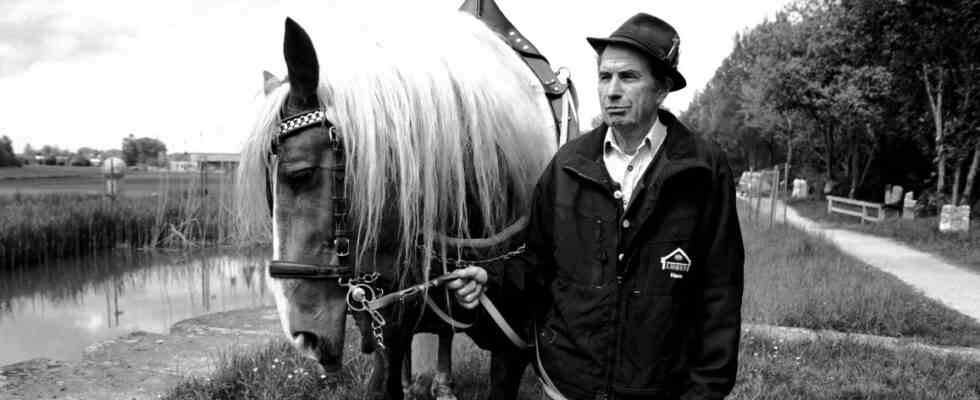The most memorable place to ponder the Old Canal? Maybe that’s even the canal monument in Erlangen, one of the most unreal spots in the Free State. At its foot, the noise of a country road, an arterial road and a motorway roars, called “Frankenschnellweg”. And above it is enthroned this huge monument, with which an inscription reminds us that Charlemagne had already tried to connect the “Danube and Main for shipping” with each other – but this was only to be granted to Ludwig I on July 15, 1846, the Bavarian king.
Why is it that you can ponder the Old Canal particularly well there, in this extremely uncomfortable place? First of all, because you can get a feeling there for why Bavaria’s longest monument has such a neglected existence in the minds of many – whoever asks about it, all too often sees empty faces. And secondly because this story of gradual oblivion must have already begun there, at that monument. And that was already in the days of kings. After ten years of construction, after the completion of a waterway connection of the “Orient with the Occident”, as contemporaries cheered, after this unparalleled engineering masterpiece, a specially composed canal waltz was played there in 1846. But one thing was missing: the king himself, Her Majesty, the driving force, enforcer and implementer of this historic major project. It’s like Edmund Stoiber skipping the inauguration of the Transrapid at Munich Central Station – if it had existed.
In many places, the old canal runs through the landscape as if it had been built just a few decades ago. Other sections have long since disappeared under asphalt and concrete.
(Photo: Wolf-Dietrich Nahr)
Did someone – that is, Ludwig, not Stoiber – have had a historically keen sense of the fact that the artificial river course was soon to go down the drain? Wolf-Dietrich Nahr deliberately leaves this open in his captivatingly beautifully illustrated volume “People on the Old Canal. Life on King Ludwig’s Waterway” (published in 2022 by Battenberg Gietl Verlag). You just don’t know. But the suspicion is already obvious: after all, it was the king himself who exposed his pan-European waterway – on which sources say up to 9,000 people are said to have worked – to the direct competition of another modern means of transport: the railway. Goods could be transported across the country much more cheaply and faster on the route that Ludwig I. pushed forward through his kingdom than with the towboats on the outrageously expensive canal.
The Old Canal was only profitable for a few years. It soon went downhill.
The 170-kilometer waterway from Kelheim to Bamberg – today spanning a total of five Bavarian administrative districts – proved to be quite profitable for a few years. But soon it went downhill. Until the old canal in places like that in the north of Erlangen, at the aforementioned canal monument, was ruthlessly built over with car routes and today it can only be recognized as an idea with a lot of imagination; in other places, especially between Berching and the southern border of Nuremberg, has become a monument. A monument, however, that has been preserved in very different ways. Whether the old lock keeper’s cottages along the canallost place” go to waste or, on the contrary, be overrun by enthusiastic visitors, that seems – as Nahr’s illustrated book impressively teaches – to be connected with the relevant monument protection authority. But above all, as is so often the case, with existing or just missing caregivers.
The hundred locks of the Old Canal were opened and closed with ancient cranks like this one.
(Photo: Wolf-Dietrich Nahr)
Nahr, who also contributed the black-and-white photos in this volume with an “analog medium-format camera”, tells of the new life on the Old Canal, not least of the aforementioned caretaker. About Richard Schuller, the “canal cleaner”, who cycles along the old towpaths almost every day (and out of pure desire to serve against the stupidity of people) with a bag and environmental tongs, cleaning the watercourse of human rubbish, and once while doing so fell headlong into the water from a plastic nuisance. Or by Hans Haderer, who is able to open one of the 100 locks in the canal with just a few movements and an old-fashioned crank. Or from the towing expert Hans Luber, who isn’t really into “looking nice” anyway, but whom Nahr caught at a particularly uncomfortable moment. Luber normally tows the “Alma Viktoria”, a historic canal ship, along the canal with around 50 guests with the help of a harnessed draft horse. When he is supposed to look into Nahr’s camera, the canal ship has not been moved out of the lift for many months, Corona. You think you can see it.
Also worth reading is the story of Helmut Beyer, a symbol of the fascination that this old canal still exerts – at least for those who know of its existence at all. Beyer has transformed lock keeper house 30 near Sengenthal in the Neumarkt district into a gem with outdoor seating. And would – that’s also possible on this basically quiet piece of land – almost fall victim to his own success. When television reported on his “Cafe zur Ludwigslust” in 2016, it was suddenly no longer just insiders from the area who wanted to taste the homemade pastries on the canal. “We were literally overwhelmed by crowds of visitors from all over Germany,” says Beyer in the volume. They almost fought for the places, in 2019 Helmut Beyer and his wife Daijana, the cake baker, temporarily closed the canal gem. When does it open again? “Not yet foreseeable,” Daijana Beyer replies when asked about it at the moment. But you will announce it in time.

